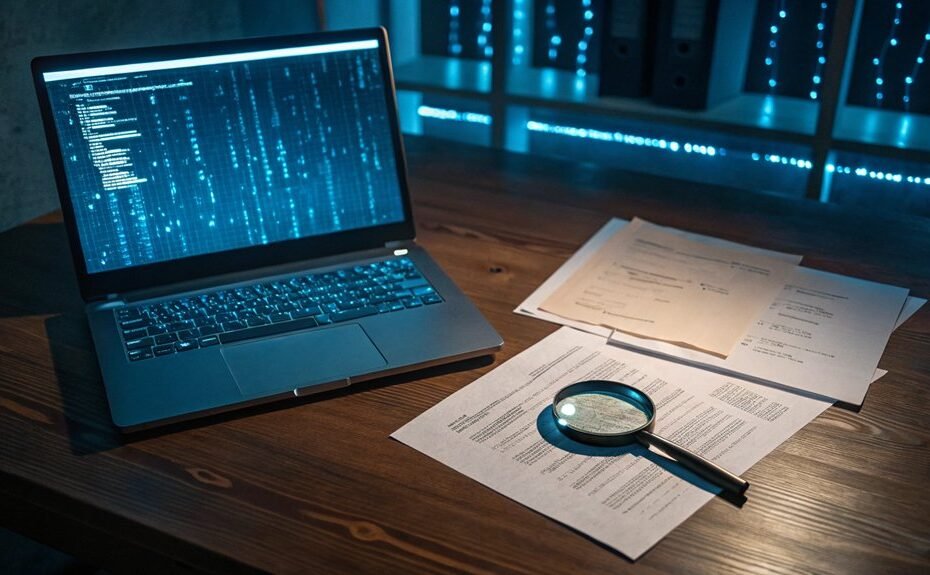AI detectors analyze text using machine learning algorithms and natural language processing to identify machine-generated content. These tools examine patterns through perplexity and burstiness metrics, with lower perplexity suggesting AI authorship. Current detection technologies achieve up to 84% accuracy by evaluating linguistic features, sentence structure, and stylometric characteristics. While not definitive, these systems serve as guidance tools across education, publishing, and social media sectors. Understanding the full scope of detection methods reveals their expanding capabilities.
With the rise of artificial intelligence writing tools, AI detectors have emerged as crucial instruments for identifying machine-generated content. These detection systems employ sophisticated technologies, including machine learning and natural language processing, to analyze texts and determine their likely origin. Organizations across education, publishing, and social media sectors utilize these tools to maintain content authenticity and integrity in their respective fields.
AI detectors operate through multiple analytical methods to assess text characteristics. The systems examine perplexity levels, which measure text predictability, with lower perplexity often indicating AI-generated content. They additionally analyze burstiness, which evaluates variations in sentence structure and length, as AI-produced text typically demonstrates less natural variation than human writing. Studies show that premium AI detection tools achieve 84% accuracy rates.
AI detection systems analyze perplexity and burstiness patterns to identify machine-generated text through its predictability and structural variations.
Advanced algorithms incorporate tokenization processes to break down text into smaller units for detailed structural analysis. The technology relies heavily on machine learning models trained on diverse datasets to recognize patterns distinctive to AI-generated content. These models utilize deep learning frameworks, including pre-trained systems like GPT and BERT, to perform binary classification of texts.
Sophisticated text analysis algorithms examine linguistic features, structural patterns, and stylometric characteristics to differentiate between human and machine-written content. Despite their utility, AI detectors face significant limitations in accuracy and reliability. The systems can produce both false positives and false negatives, leading experts to recommend their use as guidance tools rather than definitive arbiters.
Companies are exploring innovative solutions to improve detection capabilities, including the development of watermarking technologies that could help identify AI-generated content more reliably. The practical applications of AI detectors continue to expand across industries. Educational institutions employ them to verify student work authenticity, while publishers use them to guarantee content originality.
Recruitment professionals utilize these tools to validate job application materials, and social media platforms implement them to combat AI-generated spam and misinformation. Looking ahead, the field of AI detection is positioned for significant advancement. OpenAI and other organizations are developing more sophisticated watermarking techniques and improved machine learning models.
These improvements aim to address the challenges posed by increasingly sophisticated AI writing tools. The industry's focus remains on developing more accurate and reliable detection methods while considering ethical implications and practical implementation across various sectors.
Most-Asked Questions FAQ
Can AI Detectors Identify Text Written in Languages Other Than English?
AI detectors can identify text in multiple languages, though capabilities vary by platform. Isgen supports 80+ languages, while others like AI Detector Pro cover fewer. Accuracy typically decreases in non-English analysis.
How Accurate Are AI Detectors When Analyzing Short Pieces of Text?
AI detectors show limited accuracy when analyzing short texts, with studies indicating detection rates below 60%. Different detection tools produce inconsistent results, especially for content between 60-130 words.
Do AI Detectors Work on Handwritten Text That Has Been Digitized?
AI detectors typically struggle with digitized handwriting because of recognition accuracy issues. The conversion process can introduce artifacts and variations that may interfere with reliable AI content detection.
Can Ai-Generated Content Be Modified to Bypass Detection Systems?
AI-generated content can be modified to bypass detection systems through specialized tools, prompt engineering, paraphrasing techniques, and text humanization processes that alter recognizable patterns in machine-written text.
Are There Any Legal Requirements for Using AI Detection Tools?
Legal requirements vary by jurisdiction, with California's SB 942 mandating AI detection tools for providers with 1M+ monthly users. Usage must comply with privacy laws and data protection regulations.
